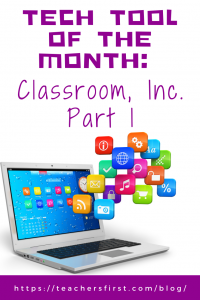Classroom, Inc. is an engaging way for your students to learn literacy and leadership skills through gameplay with virtual workspace games. This specific area of the site is called Read to Lead. There are three digital learning games where students practice literacy skills by participating as the leader of a newspaper, community center, or wellness clinic. There are also pre-game lessons that include a review of key concepts and post-game discussion questions related to 21st-century decision-making skills. Read the details of each game, including Lexile Levels, number of words, strategies, and other information. Each game has a culminating project related to choice, youth voice, and community activism. The games are self-paced and offer educators student performance reports to track writing, reading, and 21st-century skill growth. The site also offers 24/7 educator support!
Applying the Triple E Framework
The Triple E Framework, created by Dr. Liz Kolb, is built on the belief that “effective technology integration begins with good instructional strategies and not fancy tools” (tripleeframework.com). Dr. Kolb wrote a book on the topic, Learning First, Technology Second (ISTE, 2017), that lays out the three main uses for technology in education: to Engage, Enhance, or Extend learning goals. We can use this framework to decipher why we are using specific tools in the classroom. Here is a rubric based on the Triple E Framework you can use to evaluate whether Classroom, Inc. (or any other technology) is a good fit with your learning goals and whether you should use it in your lesson.

- Engage in learning goals: When using Classroom, Inc., students are more focused on the task because they are engaged in online activities and lessons as they work at their own pace. The three topics shared in the lessons/games offer real-life investigations of situations that students could experience in real life. The students are active learners, rather than just passively reading the activities. Students get to make choices about what to investigate next or where to go. Classroom, Inc. has no extra distractions or advertisements to divert students’ attention from the content and immersive activities. Students are more motivated to begin the learning process since they get to make decisions and are active participants in the activities, which are all very relatable to tweens and teens.
- Enhance learning goals: This tool allows students to use technology to make connections that allow them to understand concepts and ideas. Activities are not isolated in workbooks or stand-alone; they are connected and weaved throughout the story and activities within that lesson’s topic. Students use higher-order thinking and problem-solving skills to organize their thoughts as they work through the activities. Teachers can follow various timelines for scaffolding the activities—you can find some examples here. Classroom, Inc. takes the students to the story, rather than just having students read about it—they feel included. Most of the pages also include audio options so students can hear and read the instructions and investigations. All of these features enhance learning and offer a more sophisticated learning experience with deeper connections to the topics included in the activities.
- Extend learning goals: Dr. Kolb describes extended learning as an opportunity for students to learn, connect, and collaborate outside of the regular school day and as a bridge between the school day and real-life experiences. Completing Classroom, Inc. activities outside of the classroom would fit in with flipped, blended, and remote learning. Depending on the specific activities that you are doing, students could also work collaboratively outside of the school day. If you’re in class, students could work collaboratively or independently. Working in small groups may be a practical choice, as fewer devices would be required and students could work together through the various steps of the assigned activities. The independent learning and activities required when using Classroom, Inc. can help students build skills used outside of the classroom environment. Classroom, Inc. activities will help prepare students for learning beyond the classroom, as they will likely need to use digital tools and follow a designed plan in their future employment, education, and personal life.
SAMR Connection
The SAMR Model, by Dr. Ruben Puentedura, suggests that technology implementation has four levels. We can use this model as a guideline to analyze how we’re using technology tools in the classroom. Depending on how Classroom, Inc. is being used, it could be at the levels of Augmentation or Modification.
- Augmentation: At this level, the technology acts as a direct substitute for a tool but provides functional improvement. The activities in Classroom, Inc. can be at the augmentation level because audio, clickable images, and indicating student choice by clicking are not something that could be done using a regular textbook without technology. These improvements allow students a deeper understanding of the content.
- Modification: At this level, technology allows us to significantly change the tasks associated with our lessons or activities, meaning the activity could not be done without technology. For example, an activity at Classroom, Inc. allows students to virtually step into the role of a leader of a newspaper, community center, or wellness clinic. Achieving this would not be possible without technology.
Don’t miss Part 2 of the Tech Tool of the Month: Classroom, Inc., where we’ll discuss how to use the tool and introduce ways to use it in the classroom. In the meantime, let us know in the comment section below how you have used Classroom, Inc. in your education setting.


One thought on “Tech Tool of the Month: Classroom, Inc. Part 1”